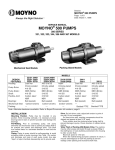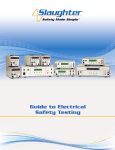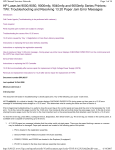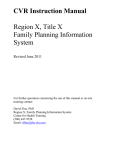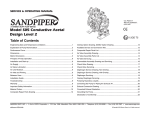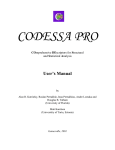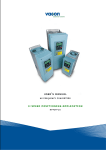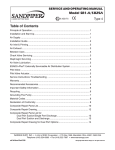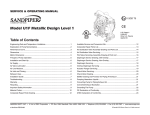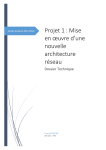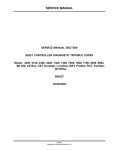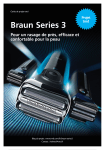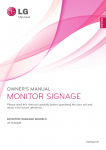Download Get Instruction Manual KAP-25
Transcript
SERVICE & OPERATING MANUAL Model PB¼-A Type 3 CE II 2GD T5 U.S. Patent # 5,996,627 and 6,241,487 Air-Operated Double Diaphragm Pump Table of Contents Engineering Data and Temperature Limitations.....................1 Performance Curve................................................................1 Explanation of Pump Nomenclature ......................................2 Dimensions ............................................................................3 Metric Dimensions .................................................................4 Principle of Pump Operation..................................................5 Check Valve Servicing ...........................................................5 Diaphragm Servicing .............................................................5 Troubleshooting .....................................................................6 Warranty ................................................................................6 Recycling ...............................................................................6 Important Safety Information .................................................6 Material Codes ......................................................................7 Installation Guide ...................................................................7 Composite Repair Parts Drawing ..........................................8 Available Service and Conversion Kits ..................................8 Composite Repair Parts List ..................................................9 Grounding the Pump .............................................................9 Solenoid Shifted Option Drawing .........................................10 Solenoid Shifted Air Valve Parts List ...................................10 Solenoid Shifted Options .....................................................11 Solenoid Connector Drawing ...............................................11 CE Declaration of Conformity ..............................................12 WARREN RUPP, INC. • A Unit of IDEX Corporation • P.O. Box 1568, Mansfield, Ohio 44901-1568 USA • Telephone (419) 524-8388 • Fax (419) 522-7867 www.warrenrupp.com pb025nmdl3sm-REV1008 Model PB¼-A Quality System ISO9001 Certified Type 3 II 2GD T5 Environmental Management System ISO14001 Certified Air-Operated Double Diaphragm Pump CE U.S. Patent # 5,996,627 and 6,241,487 Engineering, Performance & Construction Data CAPACITY INTAKE/DISCHARGE PIPE SIZE AIR VALVE 0 to 4 gallons per minute (0 to 15 liters per minute) ¼" (6mm) NPT (internal) ½" (13mm) NPT (external) SOLIDS-HANDLING No-lube, no-stall design Up to 1/32" (1mm) HEADS UP TO CAUTION! Operating temperature limitations are as follows: Materials 275°F -35°F 104°C 0°F -18°C 32°F 0°C -20°F -29°C 121°C 180°F 82°C Conductive Acetal 190°F II 2GD T5 50° to 212°F 10° to 100°C -37°C 250°F Polypropylene 50° to 212°F 10° to 100°C -40°C 220°F PVDF Optimum** -40°F 135°C Virgin PTFE Chemically inert, virtually impervious. Very few chemicals are known to react chemically with PTFE: molten alkali metals, turbulent liquid or gaseous fluorine and a few fluoro-chemicals such as chlorine trifluoride or oxygen difluoride which readily liberate free fluorine at elevated temperatures. .01 US Gallons / .04 liters Operating Temperatures Minimum* Maximum* Santoprene® Injection molded thermoplastic elastomer with no fabric layer. Long mechanical flex life. Excellent abrasion resistance. DISPLACEMENT/STROKE 100 psi or 231 ft. of water (7 bar or 70 meters) 88°C 7 PSI BAR MODEL PB¼-A Performance Curve Performance based on the following: elastomer fitted pump, flooded suction, water at ambient conditions. The use of other materials and varying hydraulic conditions may result in deviations in excess of 5%. AIR CONSUMPTION SCFM (M3/hr) 1(1.7) 100 2(3.4) 10 0P 90 SI 6 (6 .8 80 80 5 3(5.1) Ba r) 4(6.8) PS I (5 70 .44 5(8.5) Ba HEAD r) 4 60 60 6(10.2) PS I (4 50 .08 Bar ) 3 40 40 P 2 SI (2 30 .72 Bar) 20 1 20 PS I (1.3 10 0 6 Bar ) Air Inlet Press ure 0 0 .5 1.0 2.0 1.5 2.5 3.0 3.5 4.0 4.5 U.S. Gallons per minute 0 2 4 6 8 10 12 14 16 Liters per minute (SANDPIPER® pumps pb025nmdl3sm-REV1008 are designed to be powered only by compressed air) Page 1 Explanation of Pump Nomenclature PB¼-A Manifold Outer Inner Intermediate Diaphragm Outer Diaphragm Diaphragm Housing Chamber Rod Plate Plate Hardware Valve Seat Diaphragm Ball Valve Air Material Valve Cap Options Shipping Weight (lbs.) TS-3-PP PP PP PP 2011-AL PP* 416SS 301/302SS PP S S PP* PP* - 4 TU-3-PP PP PP PP 2011-AL PP* 416SS 301/302SS PP S T PP* PP* - 4 TT-3-PP PP PP PP 2011-AL PP* 416SS 301/302SS PP T T PP* PP* - 4 TS-3-K K K K 2011-AL PP* 416SS 301/302SS K S S PP* PP* - 5 TU-3-K K K K 2011-AL PP* 416SS 301/302SS K S T PP* PP* - 5 TT-3-K K K K 2011-AL PP* 416SS 301/302SS K T T PP* PP* - 5 TS-3-CA CA CA CA 2011-AL CA* 416SS 301/302SS AC S S CA* CA* - 4 TU-3-CA CA CA CA 2011-AL CA* 416SS 301/302SS AC S T CA* CA* - 4 TT-3-CA CA CA CA 2011-AL CA* 416SS 301/302SS AC T T CA* CA* - 4 TS-3-PPE0 PP PP PP 2011-AL PP* 416SS 301/302SS PP S S E PP* E0 4 TS-3-PPE1 PP PP PP 2011-AL PP* 416SS 301/302SS PP S S E PP* E1 4 TS-3-PPE2 PP PP PP 2011-AL PP* 416SS 301/302SS PP S S E PP* E2 4 TS-3-PPE3 PP PP PP 2011-AL PP* 416SS 301/302SS PP S S E PP* E3 4 TS-3-PPE4 PP PP PP 2011-AL PP* 416SS 301/302SS PP S S E PP* E4 4 TS-3-PPE5 PP PP PP 2011-AL PP* 416SS 301/302SS PP S S E PP* E5 4 TS-3-PPE6 PP PP PP 2011-AL PP* 416SS 301/302SS PP S S E PP* E6 4 TS-3-PPE7 PP PP PP 2011-AL PP* 416SS 301/302SS PP S S E PP* E7 4 TS-3-PPE8 PP PP PP 2011-AL PP* 416SS 301/302SS PP S S E PP* E8 4 TS-3-PPE9 PP PP PP 2011-AL PP* 416SS 301/302SS PP S S E PP* E9 4 TS-3-PPP0 PP PP PP 2011-AL PP* 416SS 301/302SS PP S S PP PP* P0 4 TS-3-PPP2 PP PP PP 2011-AL PP* 416SS 301/302SS PP S S PP PP* P2 4 Horizontal suction and vertical discharge are standard. All combinations of suction and discharge are available. Meanings of Abbreviations: AC = Acetal AL = Aluminum CA = Conductive Acetal** K = PVDF PP = Polypropylene SS = Stainless Steel T = PTFE S = Santoprene Kit Options 00.= None P0.= 10-30VDC Pulse Output Kit P2.= 110/120 or 220/240VAC Pulse Output Kit E0.= Solenoid Kit w/24VDC Coil E1.= Solenoid Kit w/24VDC Explosion-Proof Coil E2.= Solenoid Kit w/24VAC/12VDC Coil E3.= Solenoid Kit w/12VDC Coil Explosion-Proof E4.= Solenoid Kit w/110VAC Coil E5.= Solenoid Kit w/110VAC Explosion-Proof Coil E6.= Solenoid Kit w/220VAC Coil E7.= Solenoid Kit w/220VAC Explosion-Proof Coil E8.= Solenoid Kit with 110VAC, 50 Hz Explosion-Proof Coil E9.= Solenoid Kit with 230VAC, 50 Hz Explosion-Proof Coil SP.= Stroke Indicator Pins ATEX Compliant ONLY with no options. * Designates Glass Filled ** Note: Only Conductive Acetal equipped pumps with no options are ATEX compliant pb025nmdl3sm-REV1008 Page 2 Dimensions: PB¼-A Non-Metallic pb025nmdl3sm-REV1008 Dimension A B C Standard 7" 3 1/8" 5 1/2" Pulse Output Kit 7" 3 1/8" 5 1/2" Page 3 Metric Dimensions: PB¼-A Non-Metallic Dimension pb025nmdl3sm-REV1008 A B C Standard 178 79 140 Pulse Output Kit 178 79 140 Page 4 PRINCIPLE OF PUMP OPERATION This ball type check valve pump is powered by compressed air and is a 1:1 ratio design. The inner side of one diaphragm chamber is alter nately pressur ized while simultaneously exhausting the other inner chamber. This causes the diaphragms, which are connected by a common rod secured by plates to the centres of the diaphragms, to move in a reciprocating action. (As one diaphragm performs the discharge stroke the other diaphragm is pulled to perform the suction stroke in the opposite chamber.) Air pressure is applied over the entire inner surface of the diaphragm while liquid is discharged from the opposite side of the diaphragm. The diaphragm operates in a balanced condition during the discharge stroke which allows the pump to be operated at discharge heads over 200 feet (61 meters) of water. For maximum diaphragm life, keep the pump as close to the liquid being pumped as possible. Positive suction head in excess of 10 feet of liquid (3.048 meters) may require a back pressure regulating device to maximize diaphragm life. Alternate pressurizing and exhausting of the diaphragm chamber is performed by an externally mounted, pilot operated, four way spool type air distribution valve. When the spool shifts to one end of the valve body, inlet pressure is applied to one diaphragm chamber and the other diaphragm chamber exhausts. When the spool shifts to the opposite end of the valve body, the pressure to the chambers is reversed. The air distribution valve spool is moved by a internal pilot valve which alternately pressurizes one end of the air distribution valve spool while exhausting the other end. The pilot valve is shifted at each end of the diaCHECK VALVE SERVICING Need for inspection or service is usually indicated by poor priming, unstable cycling, reduced performance or the pump's cycling but not pumping. Remove the sixteen machine screws securing the manifold assemblies to the outer chambers. Inspect the surfaces of both check valve and seat for wear or damage that could prevent proper sealing. If pump is to prime properly, valves must seat air tight. DIAPHRAGM SERVICING Remove the two V-Band clamps securing the outer chambers to the inter mediate housing. Remove the diaphragm assembly (outer plate, diaphragm, inner plate) by turning the assembly counterclockwise using a 1/2" (1.27 cm) wrench on the outer plate lugs. (If a socket is used, it must be a six point socket.) The interior components consisting of the shaft seal and pilot valve assembly are now accessible for service. Procedures for reassembling the diaphragms are the reverse of the above. Install the diaphragm with the natural bulge outward. Install the outer diaphragm plate on the outside of the diaphragm and make certain that the large radius side of the inner plate is toward the diaphragm. Tighten the outer diaphragm plate to approximately 30 in./lbs. (3.39 Newton meters). Torque while allowing the diaphragm to turn freely with plates. Use a wrench on the outer diaphragm plate of the pb025nmdl3sm-REV1008 phragm stroke when a actuator plunger is contacted by the diaphragm plate. This actuator plunger then pushes the end of the pilot valve spool into position to activate the air distribution valve. The chambers are connected with manifolds with a suction and discharge check valve for each chamber, maintaining flow in one direction through the pump. INSTALLATION AND START-UP Locate the pump as close to the product being pumped as possible. Keep the suction line length and number of fittings to a minimum. Do not reduce the suction line diameter. For installations of rigid piping, short sections of flexible hose should be installed between the pump and the piping. The flexible hose reduces vibration and strain to the pumping system. A surge suppressor is recommended to fur ther reduce pulsation in flow. AIR SUPPLY Air supply pressure cannot exceed 100 psi (7 bar). Connect the pump air inlet to an air supply of sufficient capacity and pressure required for desired performance. When the air supply line is solid piping, use a short length of flexible hose not less than 1/2" (13mm) in diameter between the pump and the piping to reduce strain to the piping. The weight of the air supply line, regulators and filters must be supported by some means other than the air inlet cap. Failure to provide support for the piping may result in damage to the pump. A pressure regulating valve should be installed to insure air supply pressure does not exceed recommended limits. opposite side to keep rod from rotating. If the opposite chamber is assembled, the rod need not be held. EXTERNALLY SERVICEABLE MAIN AIR DISTRIBUTION VALVE To service the main air distribution, first shut-off and disconnect the air supply to the pump. Remove the four long hex cap screws and hex nuts (on opposite side of pump) which fasten the main air valve body (item 1), gaskets (item 8 and 11), muffler (item 14), and caps (item 6 and 15) to the pump. Once the main air valve body is off the pump remove the retaining rings (items 7) that hold the end caps in place. Remove the end caps (items 6) to inspect the spool and sleeve. Remove the main air spool (part of item 2) and inspect for damage or wear. Inspect the inside diameter of the main air valve (item 2) for dirt, scratches, or other contaminants. Remove and replace the sleeve if needed. When reinstalling the sleeve, apply a light coating of grease to the six o-rings (item 3) before inserting the sleeve into the main air valve body. Align the holes in the sleeve with the slots in main valve body, making sure the sleeve is centered in the bore. Clean the main air valve spool, lightly grease the orings, and insert into the sleeve flush to one end. Reinstall the end caps and retaining rings. The main air valve body is now ready to put back on the pump. Assemble the air inlet cap (item 9), valve body gasket (item 8), to the main air valve body (making sure the five rectangular slots face the air inlet cap), and the intermediate gasket onto the four hex cap- AIR VALVE LUBRICATION BETWEEN USES The air distribution valve and the pilot valve are designed to operate WITHOUT lubrication. This is the preferred mode of operation. There may be instances of personal preference or poor quality air supplies when lubrication of the compressed air supply is required. The pump air system will operate with properly lubricated compressed air supply. Proper lubrication requires the use of an air line lubricator (available from Warren Rupp) set to deliver one drop of SAE 10 non-detergent oil for every 20 SCFM (9.4 liters/sec.) of air the pump consumes at the point of operation. Consult the pump’s published Performance Curve to determine this. When the pump is used for materials that tend to settle out or solidify when not in motion, the pump should be flushed after each use to prevent damage. (Product remaining in the pump between uses could dry out or settle out. This could cause problems with the diaphragms and check valves at restart.) In freezing temperatures the pump must be completely drained between uses in all cases. AIR LINE MOISTURE Water in the compressed air supply can create problems such as icing or freezing of the exhaust air, causing the pump to cycle erratically or stop operating. Water in the air supply can be reduced by using a point-of-use air dryer to supplement the user’s air dr ying equipment. This device removes water from the compressed air supply and alleviates the icing or freezing problems. Figure 1 AIR INLET AND PRIMING To start the pump, open the air valve approximately ½ to ¾ turn. After the pump primes, the air valve can be opened to increase air flow as desired. If opening the valve increases cycling rate, but does not increase the rate of flow, cavitation has occurred. The valve should be closed slightly to obtain the most efficient air flow to pump flow ratio. Figure 2 screws and install onto the pump. Slide the muffler (item 14) and the exhaust cap (item 15) over the capscrews. Re-install the washers (item 10) and hex nuts (items 16) onto the four hex capscrews and torque to 30 in/lbs. (3.39 Newton meters). SERVICING THE PILOT VALVE To remove the pilot valve spool (item 23) first remove the end o-ring (item 24) from one end of spool. Slide the spool out of the sleeve and inspect the five remaining o-rings (items 24) for damage or wear. If necessary, replace damaged o-rings. Inspect the inner diameter of pilot valve sleeve (item 20) for scratches, dirt, or other contaminants. Replace the sleeve if necessary. To remove the sleeve first remove the retaining ring from one end. When installing a pilot valve sleeve first lightly grease the six o-rings (items 21). Insert the sleeve into the chamfered end of bore on the intermediate bracket (item 13). Push the sleeve in until the shoulder is flush to intermediate bracket surface and install the retaining ring (item 22). To install the pilot valve spool first lightly grease the four interior o-rings and insert into the pilot valve sleeve. After inserting the spool into the sleeve install the remaining loose o-rings onto spool. S E RV I C I N G D I A P H R AG M RO D SEALS To service the rod seals (item 18) first remove pilot valve, then remove the inserts on each of the intermediate brackets (item 17) by pr ying them out with a small flat screwdriver. After removing the inserts take the K-R rod seals out of the inserts and replace. When reinstalling the seals, make sure the open side of the seals face into the counterbore in the inserts. To install the inserts into intermediate bracket, simply press the insert into the counterbore in each of the intermediate bracket, making sure that the closed side of insert faces out. The inserts should be flush to the surface of the intermediate bracket or slightly below the surface when fully installed. Figure 3 Figure 4 Page 5 TROUBLESHOOTING Possible Symptoms: • Pump will not cycle. • Pump cycles, but produces no flow. • Pump cycles, but flow rate is unsatisfactory. • Pump cycle seems unbalanced. • Pump cycle seems to produce excessive vibration. What to Check: Excessive suction lift in system. Corrective Action: For lifts exceeding 20 feet (6 meters), filling the pumping chambers with liquid will prime the pump in most cases. What to Check: Excessive flooded suction in system. Corrective Action: For flooded c o n d i t i o n s ex c e e d i n g 1 0 fe e t (3 meters) of liquid, install a back pressure device. What to Check: System head exceeds air supply pressure. Corrective Action: Increase the inlet air pressure to the pump. Most diaphragm pumps are designed for 1:1 pressure ratio at zero flow. What to Check: Air supply pressure or volume exceeds system head. Corrective Action: Decrease inlet air pressure and volume to the pump as calculated on the published PERFORMANCE CURVE. Pump is cavitating the fluid by fast cycling. What to Check: Undersized suction line. Corrective Action: Meet or exceed pump connection recommendations shown on the DIMENSIONAL DRAWING. W h a t t o C h e ck : R e s t r i c t e d o r undersized air line. Corrective Action: Install a larger air line and connection. Refer to air inlet recommendations shown in your pump’s SERVICE MANUAL. What to Check: Check ESADS, the Externally Serviceable Air Distribution System of the pump. Corrective Action: Disassemble and inspect the main air distribution valve, pilot valve and pilot valve actuators. Refer to the parts drawing and air valve section of the SERVICE MANUAL. Check for clogged discharge or closed valve before reassembly. What to Check: Rigid pipe connections to pump. Corrective Action: Install flexible connectors and a Warren Rupp ® Tranquilizer® surge suppressor. What to Check: Blocked air exhaust muffler. Corrective Action: Remove muffler screen, clean or de-ice and reinstall. Refer to the Air Exhaust section of your pump SERVICE MANUAL. IMPORTANT Read these safety warnings and instructions in this manual completely, before installation and start-up of the pump. It is the responsibility of the purchaser to retain this manual for reference. Failure to comply with the recommendations stated in this manual will damage the pump, and void factory warranty. What to Check: Pumped fluid in air exhaust muffler. Corrective Action: Disassemble pump chambers. Inspect for diaphragm rupture or loose diaphragm plate assembly. Refer to the Diaphragm Replacement section of your pump SERVICE MANUAL. What to Check: Suction side air leakage or air in product. Corrective Action: Visually inspect all suction side gaskets and pipe connections. What to Check: Obstructed check valve. Corrective Action: Disassemble t h e we t e n d o f t h e p u m p a n d manually dislodge obstruction in the check valve pocket. Refer to the Check Valve section of the pump SERVICE MANUAL for disassembly instructions. What to Check: Worn or misaligned check valve or check valve seat. Corrective Action: Inspect check valves and seats for wear and proper seating. Replace if necessary. Refer to Check Valve section of the pump SERVICE MANUAL for disassembly instructions. What to Check: Blocked suction line. Corrective Action: Remove or flush obstruction. Check and clear all suction screens and strainers. Before pump operation, inspect all gasketed fasteners for looseness caused by gasket creep. Retorque loose fasteners to prevent leakage. Follow recommended torques stated in this manual. Take action to prevent static sparking. Fire or explosion can result, especially when handling flammable liquids. The pump, piping, valves, containers or other miscellaneous equipment must be grounded. This pump is pressurized internally with air pressure during operation. Always make certain that all bolting is in good condition and that all of the correct bolting is reinstalled during assembly. WARNING WARNING Before maintenance or repair, shut off the compressed air line, bleed the pressure, and disconnect the air line from the pump. The discharge line may be pressurized and must be bled of its pressure. WARNING Airborne particles and loud noise hazards. Wear ear and eye protection. pb025nmdl3sm-REV1008 What to Check: Blocked pumping chamber. Corrective Action: Disassemble and inspect the wetted chambers of the pump. Remove or flush any obstructions. What to Check: Entrained air or vapor lock in one or both pumping chambers. Corrective Action: Purge chambers through tapped chamber vent plugs. PURGING THE CHAMBERS OF AIR CAN BE DANGEROUS! Contact the Warren Rupp Technical Services Department before performing this procedure. Any model with top-ported discharge will reduce or eliminate problems with entrained air. If your pump continues to perform below your expectations, contact your local Warren Rupp Distributor o r fa c t o r y Te c h n i c a l S e r v i c e s Group for a ser vice evaluation. WARRANTY This pump is warranted for a period of five years against defective material and workmanship. Failure to comply with the recommendations stated in this manual voids all factory warranty. WARNING WARNING WARNING CAUTION What to Check: Blocked discharge line. C o r r e c t i v e A c t i o n : C h e ck fo r obstruction or closed discharge line valves. When used for toxic or aggressive fluids, the pump should always be flushed clean prior to disassembly. WARNING In the event of diaphragm rupture, pumped material may enter the air end of the pump, and be discharged into the atmosphere. If pumping a product which is hazardous or toxic, the air exhaust must be piped to an appropriate area for safe disposition. Before doing any maintenance on the pump, be certain all pressure is completely vented from the pump, suction, discharge, piping, and all other openings and connections. Be certain the air supply is locked out or made non-operational, so that it cannot be started while work is being done on the pump. Be certain that approved eye protection and protective clothing are worn all times in the vicinity of the pump. Failure to follow these recommendations may result in serious injury or death. II 2GD T5 CE Pump complies with EN809 Pumping Directive, Directive 98/37/EC Safety of Machinery, and Directive 94/9/EC, EN13463-1 Equipment for use in Potentially Explosive Environments. For reference to the directive certificates visit: www.warrenrupp.com. The Technical File No. AX1 is stored a KEMA, Notified Body 0344, under Document #203040000. RECYCLING Many components of Warren Rupp Metallic AODD pumps are made of recyclable materials (see chart on page 9 for material specifications). We encourage pump user to recycle worn out parts and pumps whenever possible, after any hazardous pumped fluids are thoroughly flushed. Page 6 INSTALLATION GUIDE Top Discharge Ball Valve Unit 1 Available from Warren Rupp 1 DA05 Non-Metallic Surge Dampener Surge Dampener Limited to 100 psi 2 020-049-000 Filter/Regulator 3 Air Dryer CAUTION The air exhaust should be piped to an area for safe disposition of the product being pumped, in the event of a diaphragm failure. 3 2 pb025nmdl3sm-REV1008 Page 7 pb025nmdl3sm-REV1008 Page 8 37 37 33 33 35 27 31 26 16 28 43 10 30 476-129-000 476-117-644 476-117-600 476-117-354 475-149-520 475-149-552 031-101-000 475-145-000 475-154-000 031-107-551 031-107-503 15 25 29 18 14 17 Main Air Valve Body Assembly Main Air Valve Body Assembly (Conductive Acetal only) Pilot Valve Assembly Air Exhaust Conversion Kit Air Exhaust Conversion Kit (Conductive Acetal only) Pail Transfer Kit in PVDF Pail Transfer Kit in Polypropylene Wetted End Kit Santoprene Diaphragms & Balls Wetted End Kit PTFE Diaphragms & Balls Wetted End Kit Santoprene Diaphragms & Balls Air End Kit Service & Accessory Kits 32 34 32 34 39 13 18 22 20 21 12 3 6 19 6 18 3 7 24 1 8 10 25 17 17 7 3 2 28 9 11 38 30 40 43 29 40 26 38 41 40 41 27 42 32 31 32 37 40 39 33 34 37 35 38 33 34 37 Composite Repair Parts List ITEM PART NO. 1 2 3 6 7 8 9 10 11 12 13 14 15 16 17 18 19 20 21 22 23 24 25 26 095-077-551 095-077-503 031-106-000 560-101-360 165-074-551 165-074-503 675-051-115 360-085-360 360-085-379 165-072-551 165-072-503 901-037-115 170-103-115 360-084-360 360-084-379 114-019-551 114-019-503 530-022-550 165-073-551 165-073-503 545-003-115 449-021-551 449-021-503 720-031-359 685-046-120 755-038-000 560-066-360 675-047-115 775-038-000 560-029-374 612-147-150 286-069-354 DESCRIPTION Body, Main Air Valve Body, Main Air Valve Sleeve & Spool Set O-Rings Cap, End with O-Ring Cap, End with O-Ring Ring, Retaining Gasket, Valve Body Gasket, Valve Body (Conductive Acetal Only) Cap, Air Inlet Cap, Air Inlet Washer, Flat 1/4" Capscrew, Hex Head 1/4-20 5" Long Gasket, Intermediate Bracket Gasket, Intermediate Bracket (Conductive Acetal Only) Intermediate, Bracket Intermediate, Bracket Muffler Cap, Air Exhaust Cap, Air Exhaust Nut, Hex 1/4-20UNC Insert, Gland Insert, Gland Seal, K-R Rod, Diaphragm Sleeve, Pilot Valve with O-rings O-rings Ring, Retaining - Pilot Valve Sleeve Spool, Pilot Valve with O-rings O-rings Plate, Inner Diaphragm Diaphragm QTY 1 1 1 8 2 2 2 1 1 1 1 8 4 1 1 1 1 1 1 1 4 2 2 2 1 1 6 1 1 6 2 2 ITEM 27 28 29 30 31 32 33 34 35 37 38 39 40 41 42 43 54 PART NO. DESCRIPTION 286-070-600 612-146-520 612-146-502 612-146-552 200-057-115 100-002-115 545-027-337 196-145-520 196-145-502 196-145-552 720-032-600 722-073-520 722-073-506 722-073-552 050-033-354 050-034-600 312-095-520 312-095-502 312-095-552 706-023-115 544-004-115 312-096-520 312-096-502 312-096-552 720-033-600 518-127-520 518-127-502 518-127-552 518-128-520 518-128-502 518-128-552 360-086-360 920-025-000 Diaphragm 2 Plate, Outer Diaphragm 2 Plate, Outer Diaphragm 2| Plate, Outer Diaphragm 2 Clamp, V-Band 2 T-Bolt 2 Nut, Hex 1/4-28UNF 2 Chamber, Outer 2 Chamber, Outer 2 Chamber, Outer 2 Seal, Check Valve 8 Seat, Check Valve 4 Seat, Check Valve 4 Seat, Check Valve 4 Ball, Check 4 Ball, Check 4 Elbow, Suction 2 Elbow, Suction 2 Elbow, Suction 2 Screw, Machine 10-32UNF x 1" Long 32 Nut, Hex Flange 10-32UNF 16 Elbow, Discharge 2 Elbow, Discharge 2 Elbow, Discharge 2 Seal, Manifold 4 Manifold, Horizontal (Optional Discharge) ½ Manifold, Horizontal (Optional Discharge) ½ Manifold, Horizontal (Optional Discharge) ½ Manifold, Vertical 1 Manifold, Vertical 1 Manifold, Vertical 1 Gasket, Sealing 2 Grounding Cable (Conductive Acetal Units Only) 1 QTY Item not shown: ** (use in place of four 706-023-115 machine screws with horizontal manifold (item 41) on port side only when a pipe couple is installed on external 1/2" NPT porting threads. Grounding The Pump (for Conductive Acetal Pumps only) **706-025-115 Screw, Machine 10-32UNF x .88" Long To be fully groundable, the pumps must be II 2GD T5 ATEX Compliant. Refer to pump data sheet for ordering. One eyelet end is fastened to the pump hardware. One eyelet is installed to a true earth ground. (Requires a 5/16 or 8mm maximum diameter bolt) This 8 foot long (244 centimeters) Grounding Cable (Item 54) is shipped with the eyelet fastened to the pump hardware. To reduce the risk of static electrical sparking, this pump must be grounded. Check the local electrical code for detailed grounding instruction and the type of equipment required. WARNING Take action to prevent static sparking. Fire or explosion can result, especially when handling flammable liquids. The pump, piping, valves, containers or other miscellaneous equipment must be grounded. pb025nmdl3sm-REV1008 Page 9 ASSEMBLY INSTRUCTIONS: Must Be Solenoid Shifted Option Drawing SOLENOID SHIFTED AIR VALVE PARTS LIST (Includes all items used on Composite Repair Parts List except as shown) ITEM PART NUMBER DESCRIPTION QTY 22 675-047-115 Ring, Retaining - Pilot Plug Sleeve 2 44 755-037-000 Pilot Plug Sleeve with O-rings 1 45 360-106-360 Gasket, Intermediate Bracket 1 46 241-001-000 Connector, conduit 1 47 893-095-000 Solenoid Valve, NEMA 4 1 48 219-001-000 Solenoid Coil, 24 VDC 1 219-004-000 Solenoid Coil, 24 VAC/12 VDC 1 219-002-000 Solenoid Coil, 120 VAC 1 219-003-000 Solenoid Coil, 240 VAC 1 49 866-068-000 Tube Fitting 1 50 538-083-555 Nipple 1 51 835-009-555 Tee, Pipe 1 52 860-062-540 Tubing 1 53 866-069-000 Tube Fitting 1 Performed Prior To Start-Up. The tee (item 51), nipple (item 50), fitting (item 53) and tubing (item 52) have been pre-assembled at the factory. Thread this assembly into the air inlet cap (item 9). Be careful not to over tighten. Push the free end of the tubing into the fitting (item 49) which is attached to the valve. FOR EXPLOSION PROOF SOLENOID VALVE 48 219-009-001 219-009-002 219-009-003 219-009-004 219-009-005 Solenoid Coil, 120VAC 60 HZ Solenoid Coil, 240VAC 60 HZ Solenoid Coil, 12VDC Solenoid Coil, 24VDC Solenoid Coil, 110VAC 50 HZ 219-009-006 Solenoid Coil, 230VAC 50 HZ pb025nmdl3sm-REV1008 1 1 1 1 1 1 Page 10 SOLENOID SHIFTED AIR DISTRIBUTION VALVE OPTION Warren Rupp’s solenoid shifted, air distribution valve option utilizes electrical signals to precisely control your SANDPIPER’s speed. The solenoid coil is connected to a customer - supplied control. Compressed air provides the pumping power, while electrical signals control pump speed (pumping rate). OPERATION The Solenoid Shifted SANDPIPER has a solenoid operated, air distribution valve in place of the standard SANDPIPER’s pilot operated, air distribution valve. Where a pilot valve is normally utilized to cycle the pump’s air distribution valve, an electric solenoid is utilized. As the solenoid is powered, one of the pump’s air chambers is pressurized while the other chamber is exhausted. When electric power is turned off, the solenoid shifts and the pressurized chamber is exhausted while the other chamber is pressurized. By alternately applying and removing power to the solenoid, the pump cycles much like a standard SANDPIPER pump, with one exception. This option provides a way to precisely control and monitor pump speed. BEFORE INSTALLATION Before wiring the solenoid, make certain it is compatible with your system voltage. Solenoid Connector Before wiring, remove terminal block from conduit connector. pb025nmdl3sm-REV1008 Wiring Diagram 3rd Terminal for ground. #2 Terminal Neutral (Negative) #1 Terminal Power (Positive) Page 11 Declaration of Conformity Warren Rupp, Inc., 800 North Main Street, Mansfield, Ohio, certifies that Air-Operated Double Diaphragm Metallic Pumps Series: HDB, HDF, M Non-Metallic, S Non-Metallic, M Metallic, S Metallic, Containment Duty, Gas, UL, High Pressure, W, Submersible and Tranquilizers comply with the European Community Directive 98/37/EC, Safety of Machinery. This product has used EN 809, Pumps and Pump Units for Liquids - Common Safety Requirements harmonized standard to verify conformance. October 20, 2005 Signature of authorized person Date of issue David Roseberry Engineering Manager Printed name of authorized person Title CE














